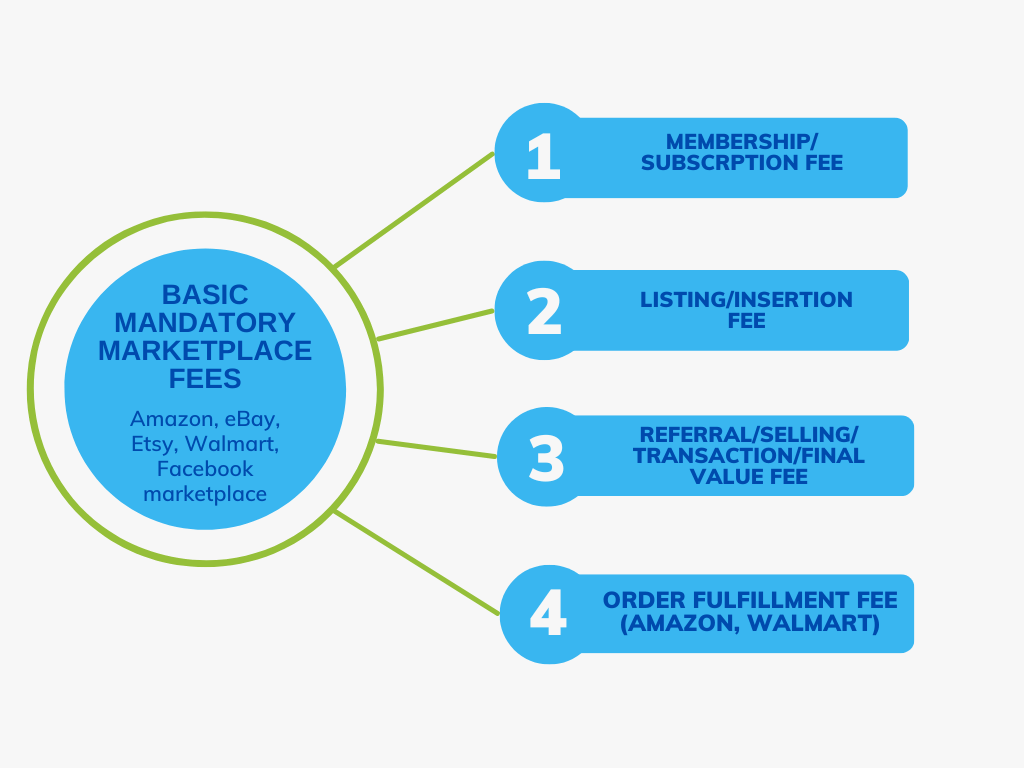If you’re looking for effective ways to expand your e-commerce business, you might eventually consider embracing the potential of online marketplaces. While concerns about marketplace fees often hold back many business owners, a guide into what it costs to join a marketplace as well as choosing a viable accounting integration should be of great help. It’s crucial to dig deep into this topic to be able to make informed business decisions.
Understanding the diverse range of fees charged will surely help assess the suitability of different marketplaces for your e-commerce business. Let’s get into details of Amazon, eBay, Etsy, Walmart, Facebook marketplace seller fees and see how these marketplaces compare in terms of charging their sellers.
Contents:
2. Most typical fees a marketplace charges
7. Facebook marketplace seller fees
8. Managing your marketplace fees

What is a marketplace fee?
Marketplace fees are typically charged to sellers who use the marketplace to sell their products or services. If we look at marketplace fees from the side of a marketplace, it’s a solid way to generate revenue, cover operating costs like hosting, customer support, and marketing and make sure that sellers are serious about selling on a marketplace. From a seller’s perspective, paying a fee guarantees getting access to a large customer base, which all e-commerce businesses strive for. Additionally, marketplaces can provide sellers with a number of features that can help them sell more products, such as listing tools, shipping integration, and payment processing.
Here are some basic need-to-know facts about marketplace fees:
- Marketplace fees can vary depending on the marketplace. Some marketplaces charge a flat fee per listing, while others charge a percentage of the sale price or both.
- Marketplace fees are typically paid by the seller, but some marketplaces charge buyers a fee as well. For example, eBay charges a fee for buyers to use the “Buy It Now” feature that allows them to purchase an item immediately without having to wait for an auction to end. Another example is Amazon, which charges a fee for buyers to use its Prime service. Prime members get free two-day shipping on eligible items, as well as access to other benefits such as streaming movies and TV shows.
- Marketplace fees can be a significant expense for sellers, so it’s important to factor them into your pricing when setting up your store.
- There are a number of ways to reduce your marketplace fees, such as selling high-margin products, offering free shipping, and using a marketplace that offers a low fee structure.
All in all, if you are considering selling on an online marketplace, it’s important to understand the marketplace fees involved, so that you can choose a marketplace that works best for your business.
Most typical fees a marketplace charges
Now, let’s look closer at the fees of different marketplaces with the focus on the basic mandatory categories, having in mind that each marketplace may have slightly different names to these four categories (in the picture below):
1. Membership (subscription) fee
2. The fee charged when you list an item
3. The fee charged when an item is sold
4. Order fulfillment fee (Amazon and Walmart)

Amazon seller fees
Amazon gives their sellers access to over 300 million active customers in about 180 countries worldwide. There are different fees that Amazon charges for this customer base, and the amount of each fee can vary depending on the product, the category in which it’s sold, and the selling plan type.
Membership (subscription) fee
Amazon provides two types of selling plans: individual and professional. With the Amazon individual selling plan, the seller pays $0.99 per item sold, while the Amazon professional selling plan charges $39.99 per month, regardless of how many items are sold. Choosing an individual account makes sense if you’re not planning to advertise or use advanced selling tools, or if you’re selling less than 40 items per month. Otherwise, opting for a professional account makes sense. Amazon selling plan fees look pretty much similar to the fees for joining Amazon.
Listing fee
Amazon charges high-volume listing fees when a seller has a high volume of active, non-media listings that haven’t sold in 12 months. There’s a monthly fee of $0.005 per listing, with the first 100,000 listings for free.
In addition to these fees, Amazon may also charge sellers for other services, such as advertising, inventory refund administration fees, premium account services.
The total amount of fees that a seller pays to Amazon can vary significantly depending on many factors, so it’s best to consider all the fees involved carefully.
Referral fee
A referral fee is charged on every sale made on Amazon. It’s a percentage of the total price which varies depending on the product category or a fixed minimum amount, whichever is greater. For example, the referral fee for computers is 8%, while the referral fee for clothing and accessories is 17%. Referral fee minimum is $0.30.
Fulfillment fee
A fulfillment fee is charged for storing and shipping products using Amazon’s fulfillment network. The FBA fee is a combination of storage fees, pick and pack fees, and shipping fees. The amount of the FBA fee varies depending on the size and weight of the product, as well as the distance it’s being shipped.
When the fulfillment by seller option is chosen, Amazon charges shipping rates based on the product category and shipping service selected by the customer, and then passes the amount to the seller in the form of a shipping credit.
eBay seller fees
eBay’s sellers have access to about 138 million active buyers worldwide as of the second quarter of 2022. Seller fees on eBay are charged for listing and selling items on the platform. These fees can vary depending on the category of the product, the listing format, and the seller’s subscription level.
Membership (subscription) fee
eBay offers their seller five different types of stores to open:
- Starter Store-$4.95 per month with annual subscription
- Basic Store-$21.95 per month with annual subscription
- Premium Store-$59.95 per month with annual subscription
- Anchor Store-$299.95 per month with annual subscription
- Enterprise Store-$2,999.95 per month with annual subscription
Choosing the right option depends on how many items per month the business is planning to list, and the perks obviously grow from tier to tier.
Insertion fee
An insertion fee is charged when a product is first listed on eBay, which may as well be called a listing fee. The insertion fee varies depending on the listing format and the seller’s subscription level. For example, the Starter Store subscription has 250 free auction or fixed-price listings per month and $0.30 per listing for additional items, while Basic Store offers 1000 free fixed-price, 250 free auction listings and $0.25 per additional listings in each category.
Final value fee
Final value fee is a percentage of the total amount of sale, adding a flat fee of $0.30. The total amount of sale includes the product price, any handling charges, the shipping service the buyer selected, sales tax, and any other applicable fees. The percentage of the total amount of sale that is charged varies depending on the category of the item sold. For example, the final value fee for most categories is 13.25%, but it’s lower for some categories, such as Musical instruments (6.35%).
In addition, eBay might charge other fees in certain situations (international fee, dispute fee) and for certain features, such as the ability to list items in multiple categories or to have your listings featured on the homepage, so the final price of selling on eBay depends on many factors.
Etsy seller fees
Etsy is a marketplace that can turn your creativity into a profitable e-commerce business by attracting more than 96 million active buyers. Etsy seller fees give you access to this impressive customer base. The category of the item, the listing format, the seller’s subscription level are just some of the factors contributing to Etsy seller fees. Let’s look at the most important of them.
Membership (subscription) fee
Etsy offers to their sellers two types of subscriptions:
- Etsy Standard-free
- Etsy Plus-$10 per month
Etsy Plus gives you various benefits like discounts on domain customization, packaging and promotional materials, listing and ads credits, etc.
Listing fee
A listing fee is charged when an item is first listed on Etsy. The listing fee is $0.20 per listing, which expires after four months. Auto-renewal for expired listings costs $0.20 per listing that isn’t sold after four months. A multi-quantity fee of $0.20 is added to the listing fee when a customer buys multiple units of the same product that don’t come as a single pack. Private listing fee is the same $0.20 when you want to make a listing visible to some clients, for example, only to your most loyal ones.
Transaction fee
A transaction fee is charged when an item sells on Etsy and since April 2023 equals 6.5% of the sale price, plus $0.25. This fee applies to shipping and gift wrapping in case you charge these.
Etsy may also charge other fees for certain features, such as advertising and promotion, subscription, in-person selling, shipping fees.
Walmart seller fees
Walmart is a great choice to expand your business beyond the popular Amazon and eBay. Walmart marketplace had 6.3% of e-commerce market share in the US, which is the 2nd place after Amazon with a staggering 37.8% as of June 2022.
Membership (subscription) fee
There’s no membership fee on Walmart now, but you need to start off with initial approval, which means that all the sellers are under the same conditions.
Listing fee
Walmart’s sellers aren’t charged any listing fees, which seems to be a significant boost to their businesses.
Referral fee
Referral fee is calculated as a percentage of the sale price of the item. The percentage of the sale price charged varies depending on the category of the item sold. Walmart’s sellers are charged 6-20% of the sale price. For example, the referral fee for most categories is 15%, while for personal computers it’s 6% and 20% for jewelry with the cost of under $250.
Fulfillment fee
Walmart Fulfillment Services (WFS) allow their e-commerce sellers to ship and store any amount of inventory without minimums or maximums. There’s a handy calculator that helps understand fulfillment fees for Walmart. The fee starts at $3.45 per 1 lb., while an item of 51 lb. will be shipped for $17.55 adding $0.40 for every extra lb.
Facebook marketplace seller fees
Facebook marketplace appeared in 2016 leveraging Facebook’s subscribers as its customer base. Facebook has roughly 2.98 billion monthly active users as of the first quarter of 2023, which is an impressive number of potential customers. The strong side of Facebook marketplace is that it helps sell products to targeted audiences.
Membership (subscription) fee
There’s no membership fee on Facebook marketplace.
Listing fee
There’s no listing fee on Facebook marketplace, but your listings must comply with Facebook’s commerce policies.
Selling fee
A selling fee isn’t charged for the items sold locally. Initially, Facebook marketplace sellers paid a 5% selling fee on all shipments or a flat fee of $0.40 on shipments of $8 or less. This 5% selling fee is waived through June 30, 2023. Starting June 1, 2023, Meta is replacing this selling fee with a flat rate.

Managing your marketplace fees
Ultimately, the choice of the best marketplace for you will depend on your specific needs and goals. By considering seller fees mentioned above, you can make an informed decision about where to sell your products. Most likely your e-commerce business isn’t going to be limited to one marketplace, rather a combination of some. That is where a solid accounting integration comes on stage, as managing all the fees of different marketplaces is quite a task. While the initial goal of accounting software is connecting your e-commerce stores to your accounting platform, there are a number of other useful features like tracking all the seller fees and providing business insights that can greatly benefit its users.
Connecting your sales channels and payment platforms to Synder Sync will create one common ecosystem and guarantee simplified reconciliation, detailed financial reports and inventory tracking. All your marketplace sales are going to be in order, making financial statement numbers add up.
You can book office hours to unlock Synder’s potential with the help of our specialists, or test Synder by signing up for a free 15-day trial.







.png)
